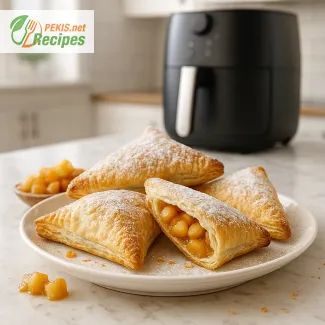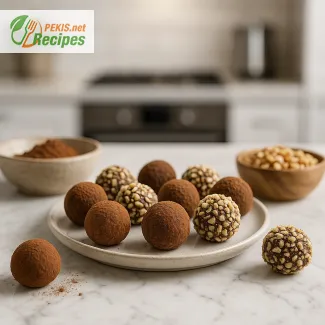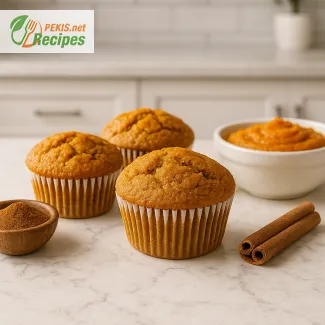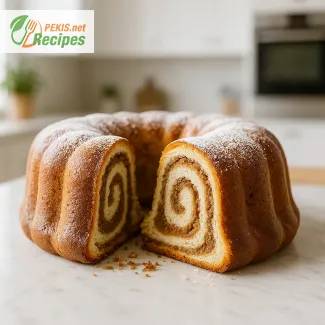
Indulge in the freshness and vibrant flavors of the New Year's Cheesecake with Oranges, a luscious dessert that embodies the spirit of celebration and the promise of new beginnings. This creamy, citrus-infused delight brings together the richness of cream cheese with the zesty, tangy sweetness of fresh oranges, creating a cake that not only tastes sensational but also feels light and refreshing, a perfect finale to your holiday feast.
The New Year's Cheesecake with Oranges is crafted for those who appreciate a dessert that balances richness with a hint of fruitiness. Unlike other festive desserts that can be overly sweet, this cheesecake has a harmonious flavor profile, thanks to the citrus notes that brighten up each bite, making it feel less heavy and more uplifting. The velvety cream cheese filling is blended with just the right amount of fresh orange juice and zest, enhancing the natural sweetness of the oranges without overpowering the senses. As you cut into this cheesecake, you'll notice its smooth, silky texture – a true treat for the palate and a delightful contrast to the usual wintery desserts.
When it comes to presentation, this cake is a true showstopper. Adorned with fresh orange slices and perhaps a sprinkle of edible gold dust or a festive glaze, it shines as the centerpiece of any New Year's spread. The natural vibrancy of the oranges gives the cheesecake a pop of color that embodies the freshness and renewal associated with the New Year. If desired, you can add a few sprigs of mint or pomegranate seeds for extra color and a festive touch, making it picture-perfect and ready for those celebratory photos.
This cheesecake isn't just about looks – it's also highly versatile. Whether served as an elegant dessert at a formal New Year's dinner or a cozy treat for a more intimate gathering, its refreshing flavor and delicate sweetness make it an ideal choice. And for those who prefer a dessert that's gluten-free, this cheesecake can easily be adapted with a nut-based or gluten-free crust, allowing everyone to enjoy a slice.
The New Year's Cheesecake with Oranges is more than just a dessert; it's a symbol of optimism and renewal. As you take each bite, the bright citrus notes and creamy texture remind you that the new year is about lightness, freshness, and celebration. Whether you’re savoring it with a glass of champagne at midnight or enjoying it as an afternoon treat, this cheesecake is a fitting end to the year and a delicious start to new adventures.
For those who value the benefits of fresh fruits in their desserts, this cheesecake brings the added bonus of vitamin C and antioxidants from the oranges, making it both a guilt-free indulgence and a boost to your well-being during the winter months. So, welcome the New Year with this delightfully fresh and fruity dessert, a cheesecake that captures the essence of celebration, citrus brightness, and pure culinary joy.
- Prepare the Crust
- In a bowl, combine the crushed digestive biscuits and melted butter until the mixture resembles wet sand. Add the sugar and stir until well mixed.
- Press the mixture into the bottom of a 23 cm (9-inch) springform pan, spreading it evenly and pressing down firmly.
- Chill the crust in the refrigerator for 15-20 minutes to set.
- Prepare the Filling
- Preheat the oven to 160°C (325°F).
- In a large mixing bowl, beat the cream cheese and sugar together until smooth and creamy.
- Add the eggs, one at a time, beating well after each addition.
- Mix in the sour cream, fresh orange juice, orange zest, and vanilla extract until fully incorporated and smooth.
- Pour the filling over the chilled crust and spread evenly.
- Bake
- Place the cheesecake in the preheated oven and bake for 45-50 minutes or until the edges are set and the center is slightly jiggly.
- Turn off the oven, leaving the door slightly open, and let the cheesecake cool in the oven for 1 hour. This helps prevent cracking.
- Chill and Add Topping
- Once cooled, refrigerate the cheesecake for at least 4 hours, preferably overnight, to allow the flavors to meld and the texture to set.
- Before serving, arrange thin orange slices on top for a fresh, citrusy garnish. If desired, sprinkle sugar on the orange slices and use a kitchen torch to create a caramelized effect.
Creating a New Year's Cheesecake with Oranges offers an opportunity to play with textures, flavors, and even nutritional elements to tailor it to personal preferences, dietary needs, or culinary creativity. Here’s a comprehensive look at how to enhance, substitute, or modify key elements in this recipe to influence the final outcome, from adjusting sweetness levels to making it gluten-free and adding unique garnishes.
1. Adjusting the Sweetness and Flavor Depth
To control the sweetness and depth of flavor, several approaches can be taken:
- Alternative Sweeteners: If you prefer a dessert that’s lower in refined sugar, you can substitute some of the granulated sugar with natural sweeteners such as honey, maple syrup, or coconut sugar. Coconut sugar, in particular, gives a hint of caramel flavor that adds richness without overpowering the orange flavor.
- Using Flavored Extracts: Vanilla extract gives a lovely warmth to the cheesecake, but if you want to enhance the citrusy tones, try adding a small amount of almond extract or even a few drops of orange blossom water. This approach will elevate the citrus notes and make the dessert feel more aromatic and festive.
- Orange Variants: Using a variety of oranges can add complexity to the cheesecake. Blood oranges add a slight berry note and a beautiful reddish hue, which enhances the visual appeal of the topping. Mandarin oranges, on the other hand, are slightly sweeter and work well if you prefer a milder flavor.
2. Modifying the Crust for Texture and Diet Requirements
The crust offers room for experimentation, allowing you to tailor it for texture or dietary needs:
- Gluten-Free Option: Substitute the digestive biscuits with a gluten-free alternative, such as crushed gluten-free graham crackers or a blend of ground nuts (like almonds) mixed with a bit of gluten-free flour. Adding a tablespoon of honey to the nut mixture helps bind it together.
- Adding Texture: For a bit of crunch, consider adding chopped nuts (like hazelnuts or almonds) to the biscuit mixture. This adds an additional layer of flavor and a delightful contrast to the creaminess of the filling.
- Different Biscuit Types: Depending on regional availability, you can experiment with other biscuit varieties. Gingerbread biscuits add a spicy note that pairs well with orange, making it more suitable for winter. If you prefer a lighter crust, use ladyfingers or shortbread, which also have a mild flavor that won’t overpower the orange.
3. Enhancing the Cheesecake Filling
The filling is the heart of the cheesecake, and small adjustments here can significantly impact its taste and texture:
- Cream Cheese Variations: Using a mix of mascarpone and cream cheese creates a softer, silkier texture that is less dense. Mascarpone has a milder flavor and a higher fat content, making the cheesecake feel more luxurious.
- Incorporating Greek Yogurt: Replacing a portion of the sour cream with Greek yogurt adds a slight tang and lightens up the filling while increasing protein content. Greek yogurt gives a smoother, silkier finish that’s still creamy without being too heavy.
- Adjusting Citrus Flavors: For an extra kick of citrus, increase the amount of orange zest slightly, or add a touch of lemon zest to create a more balanced, vibrant flavor profile. Lemon zest adds brightness without altering the orange essence.
- Adding a Swirl of Orange Marmalade: To intensify the orange flavor and create a visually interesting marbled effect, spoon small amounts of orange marmalade into the filling and swirl it lightly before baking. This creates pockets of sweetness and makes the filling visually appealing.
4. Toppings for Added Aesthetic and Flavor
Garnishes play a big role in presentation and can subtly enhance the overall flavor of the cheesecake:
- Caramelized Orange Slices: Instead of raw orange slices, caramelize them for a more complex, sophisticated topping. To caramelize, dip each orange slice in sugar, then use a kitchen torch to melt the sugar until golden brown. This creates a stunning visual effect and adds a touch of bitterness that balances the sweetness.
- Edible Flowers and Herbs: To add a fresh, unique element, garnish with edible flowers like marigolds or herbs like mint. The mint provides a pop of green, which contrasts beautifully with the oranges, while the flowers add elegance.
- Fruit Compote: Create a simple orange or mixed berry compote by simmering fruit with a bit of sugar and a splash of orange juice. Drizzle the compote over the top or around the edges before serving for an added fruity note and visual appeal.
5. Making It Dairy-Free
If you or your guests are lactose intolerant or vegan, you can make adjustments to create a dairy-free version:
- Substitute Cream Cheese: Use a dairy-free cream cheese made from nuts or soy. Look for a product that is similar in texture to regular cream cheese to maintain the same creaminess in the filling.
- Replace Sour Cream: Use coconut cream or a dairy-free yogurt (like almond or soy-based yogurt) in place of sour cream. Coconut cream adds a hint of coconut flavor, which complements the orange but will slightly change the overall flavor profile.
- Butter Alternatives: For the crust, replace the butter with coconut oil or a vegan butter substitute, which will help bind the crust and provide a similar texture.
6. Adding Nutritional Benefits
For a more nutrient-dense dessert, add ingredients that subtly enhance the nutritional profile without altering the taste or texture too much:
- Chia Seeds in the Crust: Chia seeds add fiber and essential fatty acids, making the dessert more filling. Add about a tablespoon to the crust mixture to boost nutrition without affecting the texture significantly.
- Vitamin C Powder: To enhance the antioxidant properties, add a small amount of vitamin C powder (just a pinch) to the filling. This won’t affect the taste but increases the health benefits, as vitamin C is essential for immunity and skin health.
- Protein Powder: Add a small amount of unflavored protein powder to the filling to increase protein content without affecting taste. Choose a high-quality, flavorless protein that dissolves easily.
7. Adjusting the Texture and Baking Technique
The texture of the cheesecake can vary depending on personal preference. For a lighter, airier cheesecake, follow these tips:
- Use Room Temperature Ingredients: Ensuring that all ingredients, especially cream cheese, are at room temperature helps create a smoother batter, which leads to a creamier, more consistent texture.
- Avoid Overmixing: Overmixing the batter can introduce too much air, resulting in cracks during baking. Mix ingredients just until combined to achieve a smooth texture without excess air.
- Water Bath Technique: Baking the cheesecake in a water bath helps regulate the temperature, preventing it from drying out or cracking. Wrap the springform pan in foil and place it in a larger baking dish filled with an inch of hot water before baking.
8. Making it Health-Conscious with Sugar Substitutes
If you’re looking for a way to reduce sugar content, consider these natural alternatives:
- Stevia or Erythritol: These sugar substitutes work well in cheesecake recipes as they don’t interfere with the creamy texture. Substitute half the sugar with stevia or erythritol to reduce calories without affecting taste.
- Honey or Agave: If you want to maintain natural sweetness, replace some of the granulated sugar with honey or agave syrup. These natural sweeteners pair well with orange and add a unique depth of flavor.
9. Serving and Pairing Ideas
To create a memorable presentation, serve this cheesecake with thoughtful accompaniments:
- Paired with a Citrus Sorbet: A small scoop of lemon or orange sorbet served alongside each slice can intensify the citrus experience and provide a refreshing balance to the creaminess of the cheesecake.
- Garnished with Fresh Whipped Cream: Serve with a dollop of fresh, lightly sweetened whipped cream. For a twist, add a hint of vanilla or orange zest to the cream to echo the flavors in the cheesecake.
- Paired with Sparkling Wine or Champagne: The bright citrus notes of the cheesecake make it a great dessert to enjoy with a glass of champagne or sparkling wine, especially for a New Year’s celebration.
By following these tips, you can transform the New Year’s Cheesecake with Oranges into a truly customized dessert that caters to diverse tastes, dietary needs, and festive preferences. Each adjustment enhances this cheesecake, making it not only a beautiful addition to any table but also a memorable culinary experience.
- Contains: Dairy, gluten (from the digestive biscuits), and eggs.
- Gluten-free alternative: Substitute gluten-free biscuits for the crust.
- Vitamin C: 5 mg - boosts immunity and aids in collagen production.
- Calcium: 50 mg - supports bone health.
- Vitamin A: 250 IU - essential for eye health.
- Iron: 0.5 mg - necessary for blood production.
- Beta-carotene: 15 mcg - combats oxidative stress.
- Vitamin C: 5 mg - neutralizes free radicals and promotes skin health.
Enjoy this fresh, fruity cheesecake as the perfect ending to your New Year's celebration!





